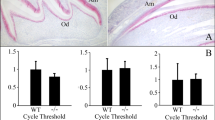Summary
The extracellular protein matrix of devoloping enamel includes a major class of proteins, the amelogenins, which are believed to be concerned in regulating enamel biomineralization. Previous studies have shown the amelogenins of the extracellular matrix to be a complex of proline-rich hydrophobic proteins which, it is suggested, arise through posttranslational and postsecretory processing of a primary ameloblast gene product. More recently, it has been shown that the human amelogenin gene is located on both the X and Y chromosomes raising the possibility that polymorphism at the level of the gene may also contribute to the observed complexity of these enamel matrix proteins. To investigate such possible amelogenin polymorphism in developing human dental enamel, individual samples of human enamel proteins were fractionated by size-exclusion and reversed-phase high pressure liquid chromatography (HPLC). Two tyrosine-rich amelogenin polypeptides (TRAPs) of approximately 5 kDa in size were isolated from an individual human dentition and characterized by automated gas-phase sequencing. These polypeptides were found to be of 42 (TRAP-2) and 44 (TRAP-1) amino acid residues in length; TRAP-2 lacked a carboxy-terminal-Gly-Trp sequence as has previously been described for analogous bovine TRAP molecules. However, residue#25 of the human TRAP-2 sequence was refractory to sequencing, apparently differing from the Trp-25 identified in TRAP-1. These findings suggest (1) two forms of TRAP molecules, differing only by cleavage of a carboxy-terminal dipeptide, are a general feature of human and other mammalian enamel proteins, probably being derived by postsecretory cleavage from the primary extracellular amelogenin; and (2) in human developing enamel four forms of TRAPs may arise either from polymorphism at the level of the gene, or by posttranscriptional alternative splicing of amelogenin mRNAs, coupled with specific postsecretory proteolytic processing.
Similar content being viewed by others
References
Snead ML, Zeichner-David M, Chandra T, Robson KJH, Woo S, Slavkin HC (1983) Construction and identification of mouse amelogenin cDNA clones. Proc Natl Acad Sci USA 80:7254–7258
Lau EC, Thuluvancheri K, Mohandas T, Shapiro LJ, Slavkin HC, Snead ML (1989) Human and mouse amelogenin gene loci are on the sex chromosomes. Genomics 4:162–168
Shimokawa H, Sobel ME, Sasaki M, Termine JD, Young MF (1987) Heterogeneity of amelogenin mRNA in the bovine tooth germ. J Biol Chem 262:4042–4047
Slavkin HC, Zeichner-David M, MacDougall M, Bessem C, Honig LS (1988) Enamel gene products during murine amelogenesisin vivo andin vitro. J Dent Res 61:1457–1471
Zeichner-David M, Vides J, Snead ML, Slavkin HC (1985) Enamel protein characterization by mRNA translation in a cell-free system. In: Butler WT (ed) The chemistry and biology of mineralized tissues. Ebsco Media Inc, Birmingham, Alabama, pp 270–272
Farge P, Couble P, Magloire H, Dallaire L (1987) mRNA characterization of human fetal enamel matrix. Archs Oral Biol 32:655–658
Fincham AG, Belcourt AB (1985) Amelogenin biochemistry: current concepts. In: Butler WT (ed) The chemistry and biology of mineralized tissues. Ebsco Media Inc, Birmingham, Alabama, pp 240–247
Fincham AG, Belcourt AB, Lyaruu DM, Termine JD (1982) Comparative protein biochemistry of developing dental enamel matrix from five mammalian species. Calcif Tissue Int 34:183–189
Crenshaw MA, Bawden JW (1984) Proteolytic activity in embryonic bovine secretory enamel. In: Fearnhead RW, Suga S (eds) Tooth enamel IV. Elsevier, North Holland, Amsterdam, pp 109–113
Fincham AG, Belcourt AB, Termine JD, Butler WT, Cothran WC (1981) Dental enamel matrix: sequence of two amelogenin polypeptides. Biosci Repts 1:771–778
Fincham AG, Belcourt AB, Termine JD, Butler WT, Cothran WC (1983) Amelogenins: sequence homologies in enamel-matrix proteins from three mammalian species. Biochem J 211:149–154
Breitbart RE, Andreadis A, Nadal-Ginard B (1987) Alternative splicing: a ubiquitous mechanism for the generation of multiple protein isoforms from a single gene. Ann Rev Biochem 56:467–495
Young MF, Shimokawa HS, Sobel ME, Termine JD (1987) A characterization of amelogenin messenger RNA in the bovine tooth germ. Adv Dent Res 1:289–292
Aoba T, Tanabe T, Moreno EC (1987) Function of amelogenins in porcine enamel mineralization during the secretory stage of amelogenesis. Adv Dent Res 1:252–260
Fincham AG, Belcourt AB, Termine JD (1983), Molecular composition of the protein matrix of developing human dental enamel. J Dent Res 62:11–15
Fincham AG, Bessem CC, Snead ML, Zeichner-David M, Slavkin HC (1987) Human amelogenins—fractionation and characterization (abstract). J Dent Res 66:335
Heinrikson RL, Meridith SC (1984) Amino acid analysis by reversed-phase high-performance liquid chromatography: precolumn derivatization with phenylisothiocyanate. Anal Biochem 136:65–74
Bidlingmeyer BA, Cohen SA, Tarvin TL (1984) Rapid analysis of amino acids using pre-column derivatization. J Chromatog 336:93–104
Fincham AG, Burkland GA, Shapiro IM (1972) Lipophilia of enamel matrix. A chemical investigation of the neutral lipids and lipophilic proteins of enamel. Calcif Tissue Res 9:247–259
Termine JD, Belcourt AB, Christner PJ, Conn KM, Nylen MU (1980) Properties of dissociatively extracted fetal tooth matrix proteins. I. Principal molecular species in developing bovine enamel. J Biol Chem 255:9760–9768
Snead ML, Lau EC, Zeichner-David M, Fincham AG, Wood SL, Slavkin HC (1985) DNA sequence for cloned cDNA for murine amelogenin reveal the amino acid sequence for enamel-specific protein. Biochem Biophys Res Comm 129:812–818
Tagaki T, Susuki M, Baba T, Minegishi K, Sasaki S (1984) Complete amino acid sequence of amelogenin in developing bovine enamel. Biochem Biophys Res Comm 121:592–597
Shimokawa H, Ogata Y, Sasaki S, Sobel ME, McQuillan CI, Termine JD, Young MF (1987) Molecular cloning of bovine amelogenin cDNA. Adv Dent Res 1:293–297
Shimokawa H, Wassmer P, Sobel ME, Termine JD (1984) Characterization of cell-free translation products of mRNA from bovine ameloblasts by monoclonal and polyclonal antibodies. In: Fearnhead RN, Suga S (eds) Tooth enamel IV. Elsevier, North Holland, Amsterdam, pp 161–166
Snead ML, Lau EC (1987) Examining the possible molecular origins for enamel protein complexity. Adv Dent Res 1:298–305
Fukae M, Smimizu M (1983) Amino acid sequence of the main component of porcine enamel proteins. Jpn J Oral Biol 25(suppl):29
Author information
Authors and Affiliations
Rights and permissions
About this article
Cite this article
Fincham, A.G., Hu, Y., Pavlova, Z. et al. Human amelogenins: Sequences of “TRAP” molecules. Calcif Tissue Int 45, 243–250 (1989). https://doi.org/10.1007/BF02556044
Received:
Revised:
Issue Date:
DOI: https://doi.org/10.1007/BF02556044




